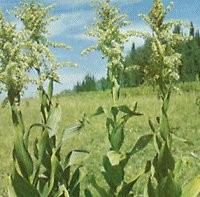VERATRUM


Description:
Leaves of the veratrum may measure 9 to 12 inches lon and 3 to 6 inches broad. Cream-colored flowers grow in clusters at the top of a single unbranched stalk in a way that resembles corn. Seed pods turn black as they ripen.
Veratrum grows in wet seepage areas, on meadows, and on hill sides. The plant reaches a height of 6 to 8 feet. It is a robust perennial of the lily family.

Veratrum, or western false hellebore, is a range plant that causes severe poisoning in sheep. It also affects cattle and goats. If ewes, nanny goats, and cows eat it during early pregnancy, veratrum causes deformities in the offspring.
The plant is sometimes called wild corn and cow cabbage.
Sheep and goats readily eat leaves and plant tops. Cattle will eat it if other forage is scarce.
The plant is poisonous from the time it starts to grow until after it is killed by freezing. The roots are 5 to 10 times as poisonous as leaves or stems. Poisonous substances in veratrum are alkaloids.

Where and When It Grows
The plant veratrum grows on moist, open meadows and hillsides at elevations of 5,000 to 11,000 feet. It emerges as soon as snow melts in the spring. Flowers appear in July and August and the plant produces seeds in September.

How It Affects Livestock
Veratrum poisoning may occur in 2 to 3 hours after an animal eats the plant. Sheep may show slight or marked signs of poisoning after eating 6 to 12 ounces of green stems or leaves.
If pregnant ewes and nanny goats eat the plant on the 14th day after breeding, the young will have a congenital deformity consisting of one central eye (cyclopia), commonly called monkey face.
Ewes carying severely deformed fetuses may fail to lamb at the end of the normal gestation period. The fetus continues to grow to an abnormal size and eventually kills the ewe unless the pregnancy is interrupted by surgery.

Signs of poisoning
1. Excessive salivation with frothing
2. General weakness.
3. Irregular gait
4. Vomiting
5. Paralysis of legs; animal unable to stand
6. Fast, irregular heartbeat
7. Slow, shallow breathing
8. Coma
9. Convulsions

BACK TO INDEX
H O M E
Would You Consider Signing
My Book?










